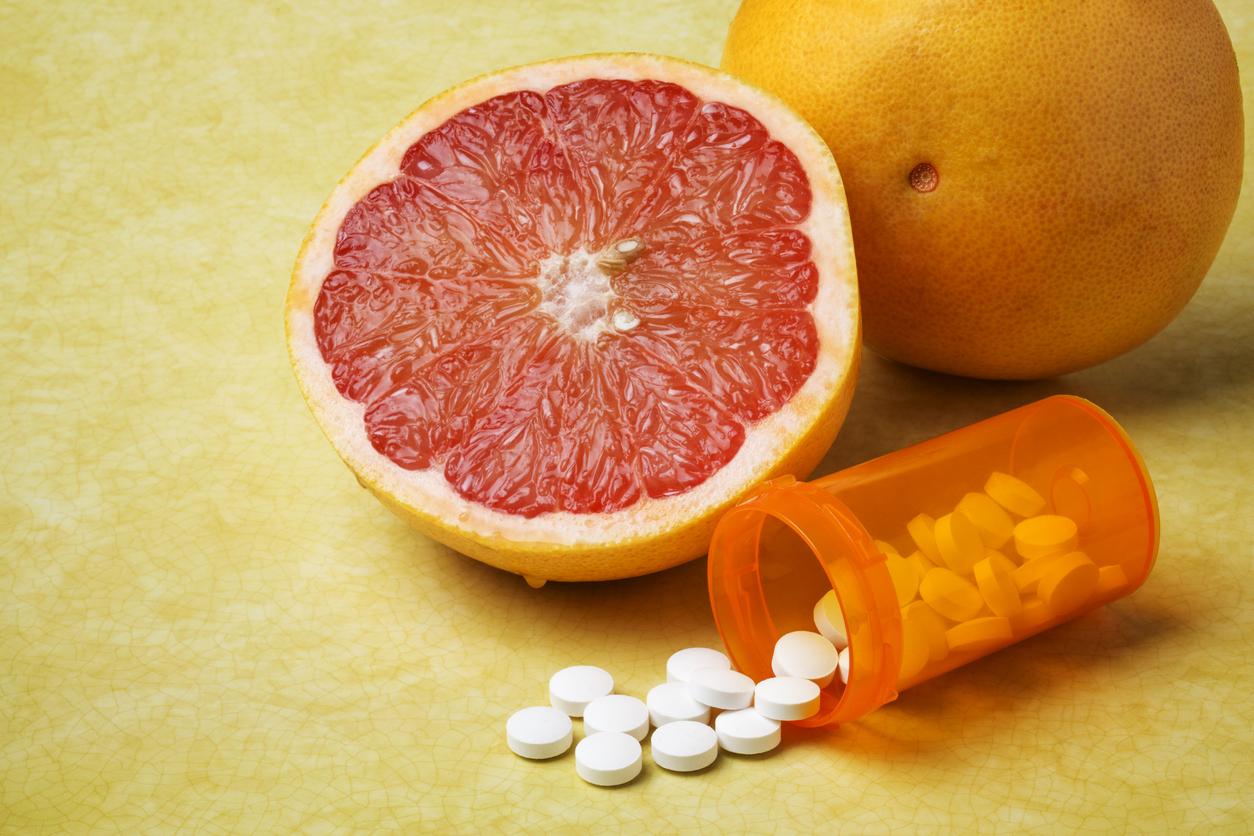Grapefruit (or rather the pomelo that we usually eat) and its juice, rich in antioxidants, vitamins, minerals and low in calories, are very popular. However, some drug leaflets indicate that it is necessary to avoid taking it, to avoid the appearance of undesirable effects or see their effectiveness diminished.
The toxic interactions between grapefruit and certain medications are due to substances, called “furanocoumarins”, which are mainly found in the white part located under the peel. These furanocoumarins do not reduce the effectiveness of drugs but they block an enzyme (called CYP3A4) essential for the assimilation and degradation by the body of certain drug molecules.
This causes an overdose of the drug which results in an increase in its undesirable effects, even the appearance of sometimes serious toxicities. People aged 70 and over seem to be more exposed to toxicities related to interactions with grapefruit. Indeed, they take more potentially affected drugs.
>> Be careful, the effects of grapefruit are felt even if he is consumed at a distance from taking the drug : for example, a glass of grapefruit juice drunk in the morning can exert its negative effect on a drug taken in the evening.
Can we drink grapefruit juice?
As industrial grapefruit juices are obtained by total pressing of the grapefruit (including the peel and the white part), this type of juice is richer in furanocoumarins than the juices pressed at home by hand. In addition, furanocoumarins are resistant to cooking and marmalades containing citrus fruits also contain significant amounts.
In other words, interactions between grapefruit and drugs are possible with the juice, with the fresh fruit, but also with preparations containing it, such as jams or candied peels.
>> Namely: grapefruit is not the only citrus fruit to contain furanocoumarins under its peel. This is also the case for bitter oranges (bitter orange, Seville orange), bergamots, limes and tangelos (hybrids between grapefruit and mandarin).
Which medications do not tolerate grapefruit?
THE Network of pharmacovigilance centers has listed the main drugs that do not tolerate grapefruit:
- certain cholesterol medications (atorvastatin, simvastatin)
- immunosuppressants or anti-rejection drugs prescribed after a transplant (ciclosporin, tacrolimus, sirolimus, everolimus, temsirolimus)
- certain medicines for high blood pressure or heart problems (lercanidipine, dronedarone, ivabradine, aliskiren, verapamil, ticagrelor)
- certain antidepressants (sertraline) or anxiolytics (buspirone)
- certain anti-cancer drugs (regorafenib)
- some erectile dysfunction drugs (avanafil, vardenafil)
- carbamazepine (anti-epileptic that can be used to treat facial neuralgia or bipolar disorder)
- halofantrine (medicine against malaria)
What about the interaction between grapefruit and contraceptive pill, often singled out? Accused of increasing the risk of phlebitis, grapefruit is often the subject of a warning for women taking oral hormonal contraception. Nevertheless, the evidence for this interaction is tenuous and the ANSM currently considers “improbable the role of grapefruit in the occurrence of phlebitis“.
What other risky foods are there?
Another problem drink, yet a source of multiple virtues: green tea. On the one hand, the tannins it contains prevent the absorption of iron, rendering iron supplements taken by people suffering from deficiencies in this mineral ineffective. On the other hand, tea is rich in vitamin K, a clotting agent. Its excessive consumption can therefore compete with anticoagulant treatments.
Certain food supplements or certain plants used in herbal medicine can interact with medications. This is for example the case of St. John’s wort, often used against depressive symptoms. It activates enzymes in the liver which will decrease the absorption rate of drugs, and therefore their effectiveness.
Licorice, used against coughs or against digestive disorders, modifies blood pressure. It will therefore interact directly with antihypertensive drugs.
Another plant to watch: Ginkgo biloba, popular with people who want to improve their cognitive functions, can increase the effect of certain antidepressants and certain antipsychotics and, on the contrary, decrease that of antiepileptics. Without forgetting ginger, whose tuber is used against nausea (car sickness or nausea of pregnancy for example) which disturbs the action of anticoagulants and antidiabetics. In the first case, it will increase the risk of bleeding and, in the second, it will raise the risk of hypoglycemia.
Last example of interaction: taurine, a dietary supplement which athletes are fond of to boost their form. Since it lowers blood pressure, it directly interferes with blood pressure medications.
Sources:
National Agency for the Safety of Medicines and Health Products (ANSM)
Navarette Sandra, Saussays Charline. Interactions between plants and drugs. Pharmaceutical sciences. 2011
















